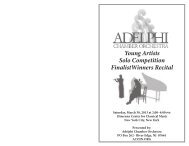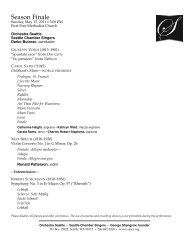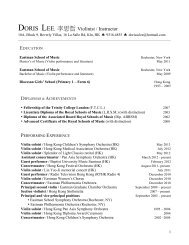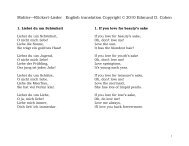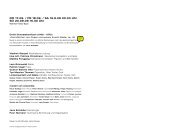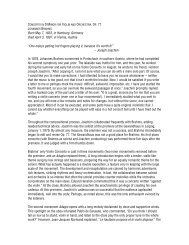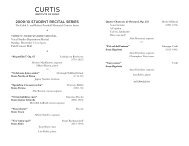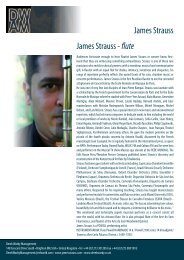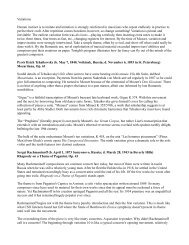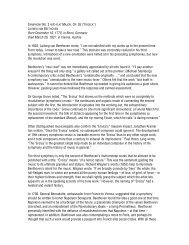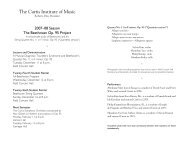Der fliegende Holländer - InstantEncore
Der fliegende Holländer - InstantEncore
Der fliegende Holländer - InstantEncore
Create successful ePaper yourself
Turn your PDF publications into a flip-book with our unique Google optimized e-Paper software.
elements of the German Romantic opera<br />
of Weber (<strong>Der</strong> Freischütz) and Marschner<br />
(<strong>Der</strong> Vampyr) together with that of French<br />
Grand Opéra (particularly evident in the<br />
original orchestration) and Opéra Comique,<br />
with more than a dash of Italian lyricism,<br />
especially apparent in the duet between<br />
the two main protagonists in Act II. But<br />
<strong>Holländer</strong> is far more than an amalgam<br />
of styles and influences: in his musical<br />
realisation of the ancient legend the young<br />
Wagner produced a work of striking<br />
originality and raw dramatic power. The<br />
original one-act version of the score,<br />
completed in 1841, was never performed<br />
but was extensively revised by Wagner<br />
in preparation for the first performance<br />
in Dresden on 2 January 1843. The<br />
manuscript of this Urfassung is preserved<br />
in the Bayreuth archives and, happily, is<br />
now available in a modern critical edition<br />
as part of the collected works. Among the<br />
main changes made before the first<br />
performance are a shift in location<br />
from the Scottish coast to Norway with<br />
a corresponding change to the names<br />
of the characters of Daland (originally<br />
Donald) and Erik (originally George)<br />
and the recasting of the work from<br />
the original one-act version to three. 1<br />
Wagner continued to revise the music<br />
for later performances, most notably the<br />
revision of the end of the overture for a<br />
concert performance in Paris in 1860 with<br />
something of the style of Tristan, which<br />
was later to form the basis of a revised<br />
version of the end of the opera itself. An<br />
important change from the 1841 score<br />
made before the premiere was the<br />
transposition of Senta’s Ballade down<br />
by a whole tone from the key of A minor<br />
to G minor, ostensibly to accommodate<br />
the declining vocal powers of Wilhelmine<br />
Schroder Devrient – the dramatic soprano<br />
and creator of the role of Senta who had<br />
such an effect on the young Wagner.<br />
1 For a detailed discussion of the possible reasons for<br />
Wagner’s last minute change of location and much<br />
more besides, see John Deathridge, Wagner Beyond<br />
Good and Evil (London: University of California Press,<br />
2008), p18-30.<br />
Tonight’s performance makes the bold<br />
step of restoring the Ballade to its original<br />
key but otherwise incorporates the later<br />
revisions. Comparison of the later versions<br />
with the 1841 score also reveals the<br />
substantial changes made to the original<br />
orchestration, a notable feature of which<br />
is the use of the ophikleide as the bass<br />
of the orchestral brass section whose<br />
‘savage and obtrusive’ (E. Prout) tones<br />
would have added extra stridency and<br />
assertiveness to the orchestral colourings.<br />
The challenge posed by <strong>Der</strong> <strong>fliegende</strong><br />
<strong>Holländer</strong> to the modern listener is to<br />
hear it through ears that are receptive to<br />
its originality and raw energy rather than<br />
through the aural filter of Wagner’s later<br />
works. In these days of plug-in digital<br />
saturation this is no easy task but, if we<br />
can thus manage to historicise the act<br />
of listening, we may experience something<br />
of the puzzlement of the audience in<br />
Dresden in the New Year of 1843, who<br />
were expecting a grand spectacle in the<br />
manner of Rienzi and found the sombre<br />
hues of Wagner’s latest work rather<br />
disconcerting. We might also come<br />
closer to understanding the significance<br />
of the work not only as an operatic<br />
masterpiece in its own right but also<br />
as a precursor of the ‘Artwork of the<br />
Future’ that was to come.<br />
© Roger Allen 2008<br />
St Peter’s College, Oxford<br />
Member of the Editorial Board<br />
of the Wagner Journal<br />
Essay 21<br />
LLO Dutchman_aw.indd 21 18/11/08 15:09:24



